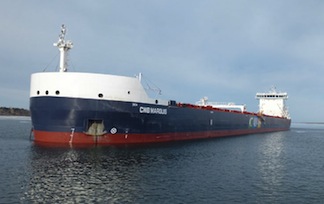The following is the text of a news release from the Transportation Safety Board of Canada (TSB):
(QUEBEC CITY) — In its investigation report released today, the Transportation Safety Board of Canada determined that delays in responding after the vessel dragged anchor due to contact with an ice floe contributed to the April 2015 grounding of the bulk carrier CWB Marquis near Beauharnois, Quebec. There were no injuries or pollution, but the vessel sustained minor damage.
On April 3, 2015, CWB Marquis was anchored for the night at the Pointe Fortier anchorage area, below the Lower Beauharnois lock, on the St. Lawrence Seaway when it was struck by an ice floe. The ice floe pushed the vessel out of the anchorage area and caused it to go aground. The vessel was refloated later that day with the assistance of two tugs.
The investigation determined that although the anchorage area itself was free of ice, most of the surrounding water was covered with fast ice — which is ice attached to the coastline or sea floor. As the wind increased during the night, an ice floe broke free and drifted into the anchorage area where four vessels, including CWB Marquis, were anchored. One of the other vessels was struck by an ice floe, but it was able to promptly raise anchor; however it did not report this event. As an ice floe later came into contact with CWB Marquis, it pushed against the anchored vessel, preventing the anchor from being raised immediately. The investigation found that a delay in crew response when the vessel began dragging anchor, combined with the time it took to raise anchor, resulted in the ship going aground outside the anchorage area.
Before the opening of the Seaway on April 2, the St. Lawrence Seaway Management Corp. (SLSMC) was responsible for the development of a vessel traffic management plan for the four vessels scheduled to enter the Seaway. Although the plan deemed it necessary to stop the four vessels in the Pointe Fortier anchorage area, the investigation determined there were shortcomings in the plan and operations. Some factors included: fast ice remained in the surrounding waters; forecasted increased winds were not taken into account; and the assisting icebreaker was directed to spend the night above the Beauharnois locks away from the four vessels.
Following the occurrence, the Algoma Central Corp., the vessel's management company, advised the SLSMC that its vessels would secure at available lock approach walls rather than anchoring in the presence of ice. Further, the corporation amended its safety management system with respect to anchoring in the presence of ice. For its part, the SLSMC added the Canadian Coast Guard manual "Ice Navigation in Canadian Waters" to its winter process toolkit.
Click here to read the complete report.

